The lifespan of an animal is something that is usually taken into consideration when thinking about whether or not to acquire one as a pet, or part of the household. Most people have a good idea of the average lifespan of cats and dogs, and most other furry pets. But the potential lifespan of ornamental fish is something that’s often overlooked by those choosing to take them into their homes.
There are several possible reasons for this, but we suspect the main reason is the general assumption among many people that fish don’t live very long. This is certainly true for some species, but very wide of the mark indeed for others. Did you know, for instance, that a common goldfish will probably outlive a horse? Or that even the smaller species, like neon tetras, can easily outlive hamsters, gerbils and rats? Many fish species can live a very long time indeed, so this is an important factor to consider when deciding on which species you would like to keep.
We’ve created the images below to help illustrate the lifespans of some popular domestic fish species compared to those of other popular domestic pets. We’ve chosen a variety of different ways to show the information as different things work for different people.
Please feel free to download, use and share them, all we ask is that you acknowledge injaf.org as the owner.
In the image below, the size of the circle relates to the length of lifespan – the bigger the circle the longer the animal is likely to live. You’ll note that the common goldfish should outlive them all!
Full size image and PDF for download:
Animal lifespans – with photos
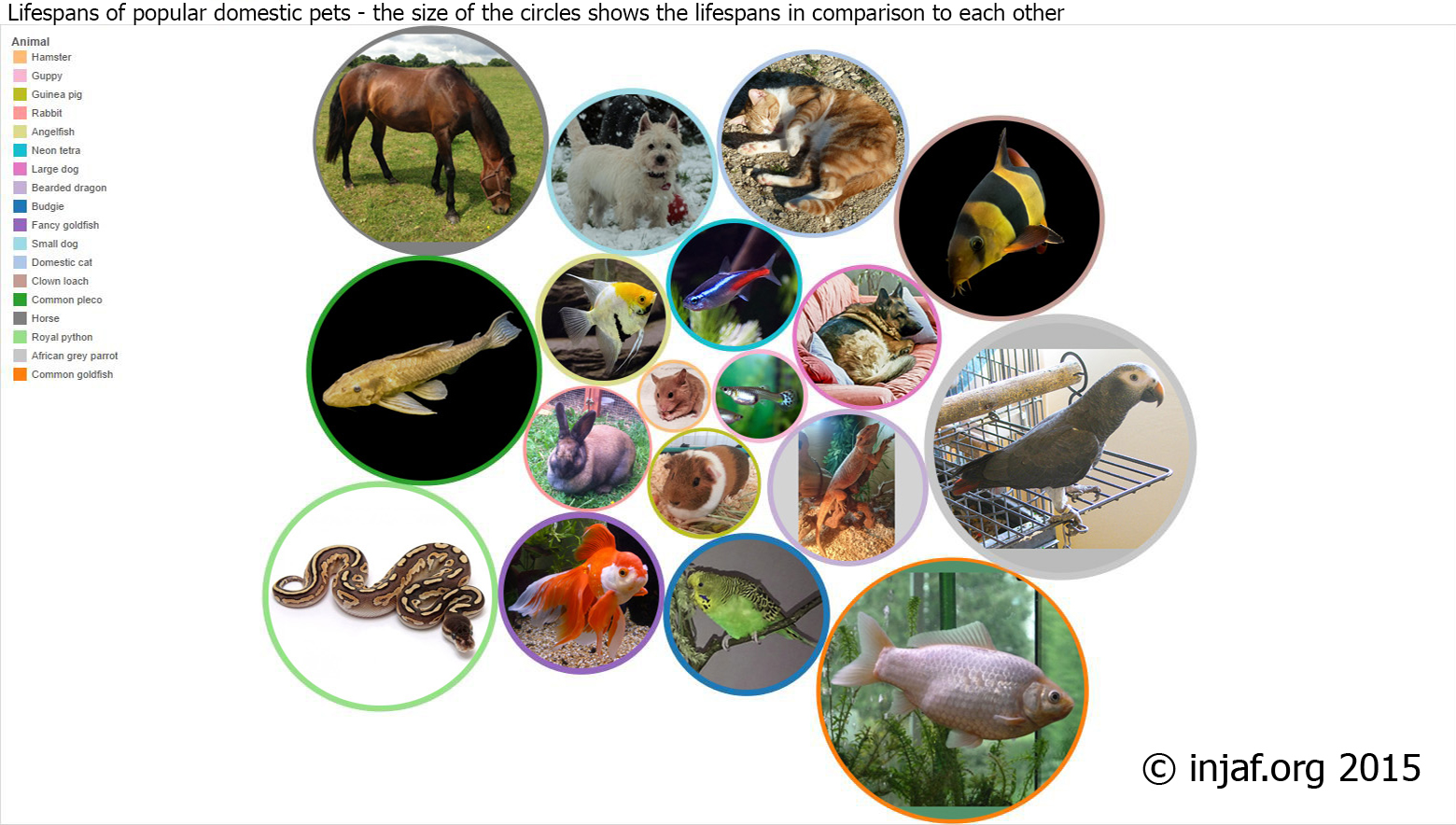
The image below shows a wider variety of popular ornamental fish species, the lifespans can vary from a year or two right the way up to a few decades. The image is interactive, hover the mouse over the pictures for more information:
In the image below, the size of the circle relates to the length of lifespan – the bigger the circle the longer the animal is likely to live.
Full size image and PDF for download:
Animal lifespans with labels
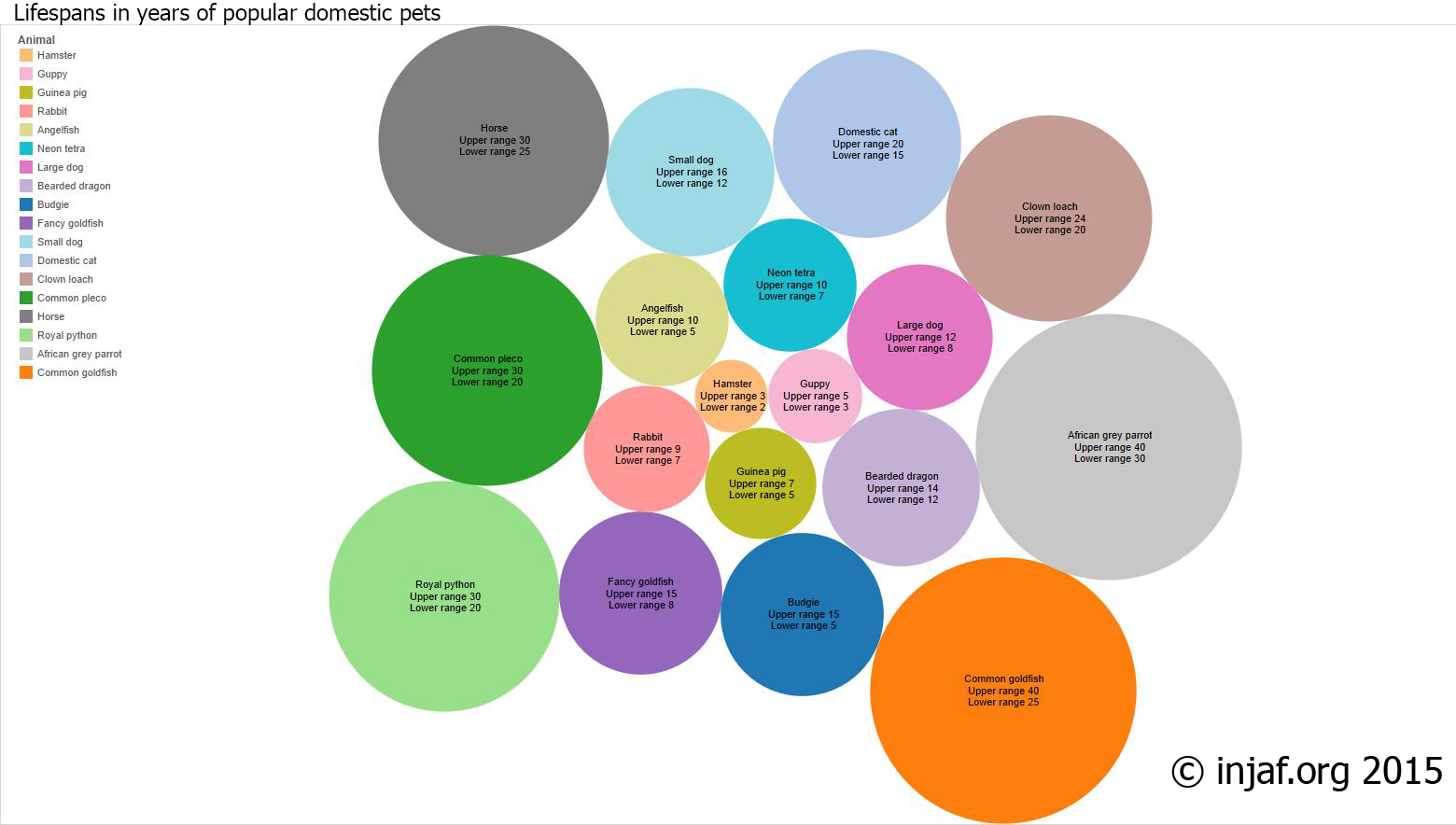
The bar chart below shows the upper and lower ranges of expected lifespans.
Full size image and PDF for download (Blue and yellow are colour blind friendly):
Animal lifespans bar chart
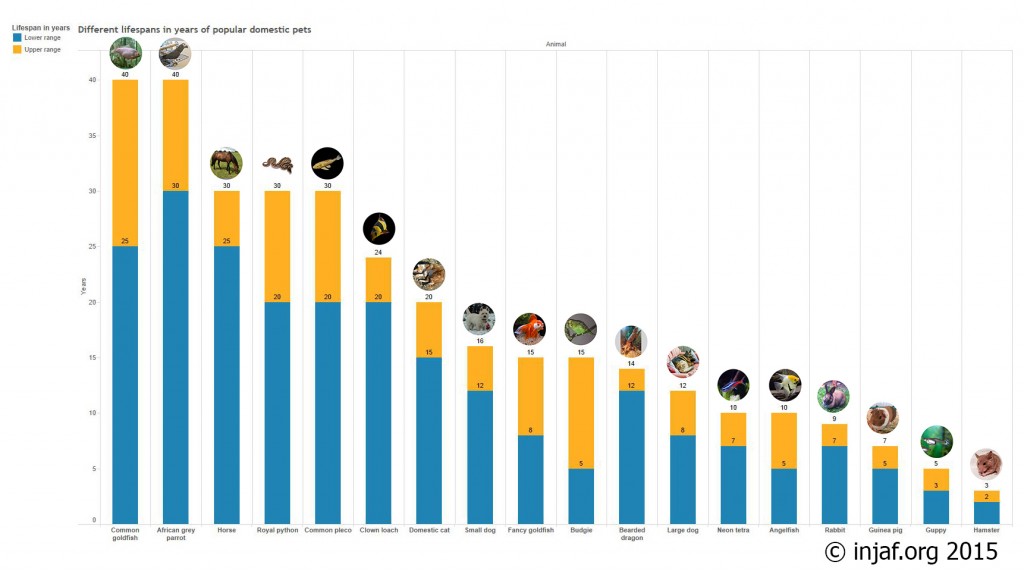
You’ll notice that the furries, with a couple of exceptions, tend towards the shorter lifespans when compared with the other animals. Parrots are well known for having long lifespans and the common goldfish is right up there with them, well ahead of the others. Hamsters, rabbits, guinea pigs and goldfish are often thought of as children’s pets, however, your eight year old child may only be ten or eleven when their hamster passes away, but could easily be heading into their forties before their goldfish does (and you’ll probably be retired!).
How long should a fish live for?
This is actually quite a tricky question to answer. We know how long most dogs, cats, rabbits and other furries will live for because they’ve been kept for many years as pets, so there is a good level of general knowledge about them. Fish have also been kept for many years as pets, many hundreds of years, but somehow there seems to be less general knowledge about them. What general knowledge there is is often incorrect, based on popular myth and ‘everyone knows’. To try and figure out a potential lifespan for a fish there are several things to consider.
What impacts on a fishes’ lifespan?
There are many things that can go wrong with fishkeeping; incorrect water conditions, wrong sized tank, wrong sort of food, wrong amount of food, incompatible tank mates, incorrect temperatures to name but a few. To keep a fish properly requires a good level of research, and understanding of their requirements. Unfortunately, for various reasons, this doesn’t always happen before someone purchases a fish and then the risks of the fish meeting an early death are significantly increased. The lack of general knowledge is such that many think they have done well if their goldfish lives for five years, when really it should easily be outliving the family dog twice over. While there are things that can go wrong when keeping furry pets, it’s probably fair to say it’s harder to get it wrong when caring for a dog than it is when caring for a fish.
Wild lifespans v domestic lifespans
There is often quite a difference between lifespans of wild fish and their domestic counterparts. Wild fish have quite a struggle for survival in many cases; they have to find their own food, defend themselves from predators, and cope with whatever environmental conditions Mother Nature throws at them. Domestic fish, while facing their own set of problems, have a regular supply of food, no predators (or at least they shouldn’t if their keeper has housed them with appropriate tank mates) and a relatively stable environment. Generally speaking, this can lead to domestic fish having the potential to live longer than their wild relations. On the other hand, some species are less likely to live as long when kept in a domestic aquarium. This could be due, for example, to very specific feeding requirements that are hard to cater for, large territory requirements to avoid fighting, or stress from incorrect living conditions.
Man-made v normal types of fish
Many ornamental fish have been line-bred, inbred or hybridised over the years to produce various body shapes and colours. The process often results in encouraging what are essentially mutations, and does not necessarily encourage the strongest gene pool. Many of these line-bred and inbred fish, such as fancy goldfish, balloon mollies and fancy guppies, are not as strong as the ‘normal’ versions of the species, and may suffer health complications as a result of their breeding. It’s generally accepted that these fish are less likely to live as long as their ‘normal’ counterparts.
Methods of breeding
A lot of the ornamental fish available in stores are from fish farms. These fish are mass-produced for the international market and, as with many mass-produced things, the quality can often suffer. Poorly bred, weaker specimens are often seen for sale and it’s less likely that these weaker fish will live as long as their fully fit, well bred counterparts. Fish farms sometimes medicate their fish heavily to try and counter the diseases and parasites that are prone to developing where stocking is very heavy and the young fish may be under stress. Use of medications can suppress problems, however, when the fish is in your home and no longer being medicated there is a chance it may relapse and exhibit signs of ill health and disease.
How did we decide on the upper and lower ranges for the animals we’ve featured?
The huge number of variables that come together to form a potential lifespan are complex, and as a result there is quite a lack of consistent and reliable data available. You’ll note that lifespan is usually missing from fish caresheets and profiles.
Using what data we could find, personal experience and the experience of others we came up with a lower age range that any healthy, properly cared for animal could reasonably be expected to reach as a minimum. The upper age ranges are those that we would expect the majority of those healthy, well cared for animals to reach to be considered as ‘old’. There will always be those that don’t reach the lower end of the range, and those that exceed the upper age range. However, we think we’ve come up with reasonable ranges that, generally speaking, people should be considering when choosing an animal.
Further reading
How long will my fish live? Jeremy Gay, Practical Fishkeeping
The age and size that fish reach Aquariofilia Consevepole (this article is in Italian but your browser should offer a translate option. INJAF has shared some articles with this site, we have very similar views on fishkeeping)
Goldfish size and life expectancy fishkeeping.co.uk
Pet Population UK 2014, a survey by the Pet Food Manufacturers Association
Tableau interactive images
To see more of our interactive images please visit our Tableau page:
Tableau
Meet the Models!
You may be thinking some of our photos don’t look all that professional, well, there’s a reason for that. All the animals featured here are, or have been, owned or cared for by one of Team INJAF, or our friends and families. We much prefer to use our own, or ‘crowd sourced’ images instead of anonymous photos from the internet as we feel it makes the animals more ‘real’, and we can tell you a little about them to help bring their stories to life.
So, meet the models!
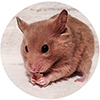 Hamster: I’m Tulip, or Fat Tulip, or Princess Fluffypants depending on the mood! I’m eighteen months old, so some might call me middle-aged (how rude!) but I’m still as cute as ever! I’m very sociable and love to be petted and handled. I like dried cranberries, almond chips, and chicken. I’ll probably have the shortest life of all us here, but I’m making every minute count.
Hamster: I’m Tulip, or Fat Tulip, or Princess Fluffypants depending on the mood! I’m eighteen months old, so some might call me middle-aged (how rude!) but I’m still as cute as ever! I’m very sociable and love to be petted and handled. I like dried cranberries, almond chips, and chicken. I’ll probably have the shortest life of all us here, but I’m making every minute count.
 Guppy: I’m Mrs Guppy, the boys often hog the limelight with their fancy colours but I think I’m more interesting, even if I’m not as flashy! A lot of the boys’ time is taken up trying to get the ladies, and showing off. Us ladies tend to explore our surroundings more; I like to come and see my keeper when she comes up to the tank and give a little hand manicure if she sticks her fingers in the tank!
Guppy: I’m Mrs Guppy, the boys often hog the limelight with their fancy colours but I think I’m more interesting, even if I’m not as flashy! A lot of the boys’ time is taken up trying to get the ladies, and showing off. Us ladies tend to explore our surroundings more; I like to come and see my keeper when she comes up to the tank and give a little hand manicure if she sticks her fingers in the tank!
 Guinea pig: I’m Gouchie and I’m six months old. I live with my friend Prinny who was rescued from very poor conditions and needed someone to keep her company, cue me! We have a lovely home now and get very well looked after. I’m very fond of fruit and veg, and particularly like a nice carrot to nibble on. Prinny and I get through quite a pile of fruit and veg between us!
Guinea pig: I’m Gouchie and I’m six months old. I live with my friend Prinny who was rescued from very poor conditions and needed someone to keep her company, cue me! We have a lovely home now and get very well looked after. I’m very fond of fruit and veg, and particularly like a nice carrot to nibble on. Prinny and I get through quite a pile of fruit and veg between us!
 Rabbit: I’m Lady Bun; I was found roaming the streets but my rescuer couldn’t keep me, so her neighbour agreed to take me to the rehoming centre. I never quite made it to the rehoming centre though and still live with the lovely neighbour! I was about three years old when I was taken in, and I’m about six now. I like parsley, dried papaya (it’s a good life here!) and cardboard boxes.
Rabbit: I’m Lady Bun; I was found roaming the streets but my rescuer couldn’t keep me, so her neighbour agreed to take me to the rehoming centre. I never quite made it to the rehoming centre though and still live with the lovely neighbour! I was about three years old when I was taken in, and I’m about six now. I like parsley, dried papaya (it’s a good life here!) and cardboard boxes.
 Angelfish: I’m Mustardseed, I’m four years old and my owner knows this for sure as she’s had me since I was an egg! My mum and dad had a rough start in life and only lived to about six years old but I have every intention of reaching my full potential. I might look all pretty and ‘angelic’ but I’m a cichlid so don’t expect me to be angelic by name and by nature, I can be quite devilish!
Angelfish: I’m Mustardseed, I’m four years old and my owner knows this for sure as she’s had me since I was an egg! My mum and dad had a rough start in life and only lived to about six years old but I have every intention of reaching my full potential. I might look all pretty and ‘angelic’ but I’m a cichlid so don’t expect me to be angelic by name and by nature, I can be quite devilish!
 Neon Tetra: We didn’t have individual names as we preferred to be known by our gang name because we always need to be in a group – the more the merrier. We enjoyed cruising round the tank together, playing hide and seek among the plants and generally spending time together. Our real name is Paracheirodon innesi, but that’s a bit of a mouthful, so “The Neons” will do!
Neon Tetra: We didn’t have individual names as we preferred to be known by our gang name because we always need to be in a group – the more the merrier. We enjoyed cruising round the tank together, playing hide and seek among the plants and generally spending time together. Our real name is Paracheirodon innesi, but that’s a bit of a mouthful, so “The Neons” will do!
 Large dog: Cain was a large German Shepherd Dog. He was a total clown and scared of thunder, wind or any strange noises. He was intelligent and loved to learn new things. Sadly he had some inherited health conditions which meant he only lived to eight. The vet predicted he had only weeks to live when he was three, for the next five years he was known at the vet’s as Cain the Wonder Dog!
Large dog: Cain was a large German Shepherd Dog. He was a total clown and scared of thunder, wind or any strange noises. He was intelligent and loved to learn new things. Sadly he had some inherited health conditions which meant he only lived to eight. The vet predicted he had only weeks to live when he was three, for the next five years he was known at the vet’s as Cain the Wonder Dog!
 Bearded Dragon: My name is Meatball and I’m about two years old. I love spending time out of my vivarium and having a good mooch about, and I love spring greens and ‘hoppers’. And I love posing, do you think this is my best side?
Bearded Dragon: My name is Meatball and I’m about two years old. I love spending time out of my vivarium and having a good mooch about, and I love spring greens and ‘hoppers’. And I love posing, do you think this is my best side?
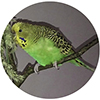 Budgie: Miley and Cyrus were rescues at about six years old and lived to about eight years old. They liked fresh seed and their owner used to have to stop when out on a morning run to collect long stemmed grass with seeds for them! They liked looking at the outdoors and sitting on the open balcony admiring the view but if anything scared them they flew straight back to their cage!
Budgie: Miley and Cyrus were rescues at about six years old and lived to about eight years old. They liked fresh seed and their owner used to have to stop when out on a morning run to collect long stemmed grass with seeds for them! They liked looking at the outdoors and sitting on the open balcony admiring the view but if anything scared them they flew straight back to their cage!
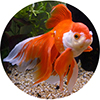 Fancy goldfish: I’m Albie, I’m six years old now. I was a terrible tearaway in my youth and very romantically inclined but I’m much more relaxed these days. I like eating (a love of food seems to be a common theme amongst us!), I love peas, bloodworm, plants (did I say plants? I meant pellets!), and the gel food my human makes which she says makes the house smell horrendous!
Fancy goldfish: I’m Albie, I’m six years old now. I was a terrible tearaway in my youth and very romantically inclined but I’m much more relaxed these days. I like eating (a love of food seems to be a common theme amongst us!), I love peas, bloodworm, plants (did I say plants? I meant pellets!), and the gel food my human makes which she says makes the house smell horrendous!
 Small dog: This little lady was called Meg, she was a West Highland white terrier, often known as a Westie. She lived for many happy years and loved getting out and about for walks, especially in the snow! She was the smallest dog in a household with two very big dogs but Meg was the boss and the big guys knew their place!
Small dog: This little lady was called Meg, she was a West Highland white terrier, often known as a Westie. She lived for many happy years and loved getting out and about for walks, especially in the snow! She was the smallest dog in a household with two very big dogs but Meg was the boss and the big guys knew their place!
 Cat: I’m Marmalade, I’m about four years old and first adopted my humans as a tiny kitten by moving in with them when they weren’t looking! I never owned up to where I’d come from, so they let me stay. I now live in France, where there is significantly better weather than my old home in the north of England, which allows me to indulge my twin passions of roaming and lying in the sun.
Cat: I’m Marmalade, I’m about four years old and first adopted my humans as a tiny kitten by moving in with them when they weren’t looking! I never owned up to where I’d come from, so they let me stay. I now live in France, where there is significantly better weather than my old home in the north of England, which allows me to indulge my twin passions of roaming and lying in the sun.
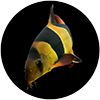 Clown Loach: I’m Papa Loach, you probably recognise me as a clown loach, but my proper name is Chromobotia macracanthus. I’m four years old and already over six inches long, but have some growing still to do and many more years ahead of me. I like to hang out with the other clown loaches in our cave and especially love dancing with them in the evening.
Clown Loach: I’m Papa Loach, you probably recognise me as a clown loach, but my proper name is Chromobotia macracanthus. I’m four years old and already over six inches long, but have some growing still to do and many more years ahead of me. I like to hang out with the other clown loaches in our cave and especially love dancing with them in the evening.
 Common Plec: I’m Hermione, I’m an albino common plec. My proper name is Pterygoplichthys pardalis and like many plecs, I’m BIG. I’m seven years old now and have pretty much reached full size at sixteen inches long. I like to just chill out during the day; when evening comes I love to stretch my fins swimming a few laps of the tank. I love courgette and can eat half of one in an evening.
Common Plec: I’m Hermione, I’m an albino common plec. My proper name is Pterygoplichthys pardalis and like many plecs, I’m BIG. I’m seven years old now and have pretty much reached full size at sixteen inches long. I like to just chill out during the day; when evening comes I love to stretch my fins swimming a few laps of the tank. I love courgette and can eat half of one in an evening.
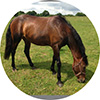 Horse: I’m Missy, I’m twenty-three but in my head I’m still three! I’m an Arab mix so I’m always full of beans and love nothing better than a good gallop across the Downs with my human in tow. Actually there is something I love more than a good gallop – bananas! I’d sell my soul for a banana.
Horse: I’m Missy, I’m twenty-three but in my head I’m still three! I’m an Arab mix so I’m always full of beans and love nothing better than a good gallop across the Downs with my human in tow. Actually there is something I love more than a good gallop – bananas! I’d sell my soul for a banana.
 Royal Python: My name is Cinnamon, I’m a colour morph of a Royal Python. I’m a female, about two years old and have a penchant for rodents, but only of the very dead variety. I’m also quite fond of my keeper’s arm; he is less fond of my attempts at demonstrating this!
Royal Python: My name is Cinnamon, I’m a colour morph of a Royal Python. I’m a female, about two years old and have a penchant for rodents, but only of the very dead variety. I’m also quite fond of my keeper’s arm; he is less fond of my attempts at demonstrating this!
 African Grey Parrot: My name is Tau (pronounced T-ow, like towel without the ‘el’!), it comes from the Tswana and Sotho languages of southern Africa (which is where I live) and means ‘lion’. I hatched in 2006 so I’m about nine years old now. One of my favourite things ever is eating dried chillis, then giving ‘kisses on the lips’ to unsuspecting people!
African Grey Parrot: My name is Tau (pronounced T-ow, like towel without the ‘el’!), it comes from the Tswana and Sotho languages of southern Africa (which is where I live) and means ‘lion’. I hatched in 2006 so I’m about nine years old now. One of my favourite things ever is eating dried chillis, then giving ‘kisses on the lips’ to unsuspecting people!
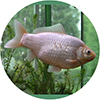 Common goldfish: I’m Howie, I’m fifteen years old now. I was a fairground prize in 2000 and now live Chez INJAF. I’m nearly twelve inches long, and quite the chunky monkey! My owner will be into her retirement by the time I reach old age, I’ll easily outlive all the furries featured here. I like hanging about with my tank mates. I’m quite lazy and like to watch the world go by.
Common goldfish: I’m Howie, I’m fifteen years old now. I was a fairground prize in 2000 and now live Chez INJAF. I’m nearly twelve inches long, and quite the chunky monkey! My owner will be into her retirement by the time I reach old age, I’ll easily outlive all the furries featured here. I like hanging about with my tank mates. I’m quite lazy and like to watch the world go by.
Author: Draco Graham-Kevan and Suzanne Constance
Photographs courtesy of Catriona Murtagh, Holly Morris, Claire Orsatti, Oscar Hall, John Currington, Paul Woollven, Suzanne Constance, Fishlady, Brigitte de Coriolis and Jared Cave.
This article came about after we were approached by a fishkeeper who liked what we were doing, felt very strongly about some of the welfare issues in the hobby, and wanted to do something to help. Never ones to turn down offers of help we had a bit of a chat and during the conversation she said “I think education should be the biggest aim, because I think a lot of people genuinely care about animals and just need to know what they’re doing wrong … maybe putting various pets (cats, dogs, rabbits, goldfish) in order of longest lifespans would maybe change certain perceptions.” Fabulous idea! We love the infographics from Practical Fishkeeping Magazine as they give a really strong message, so we thought we’d take a leaf from their book (or should that be magazine?!) and do something of our own. A lot of research and photoshopping later and here we are. As well as being a great illustration of the issue over lifespans, and perceptions of lifespans, we think this article is also a great example of how one person can make a difference. All it needed was someone to think about something they’d like to try and change for the good, and we’ve got something we really like as a result.




